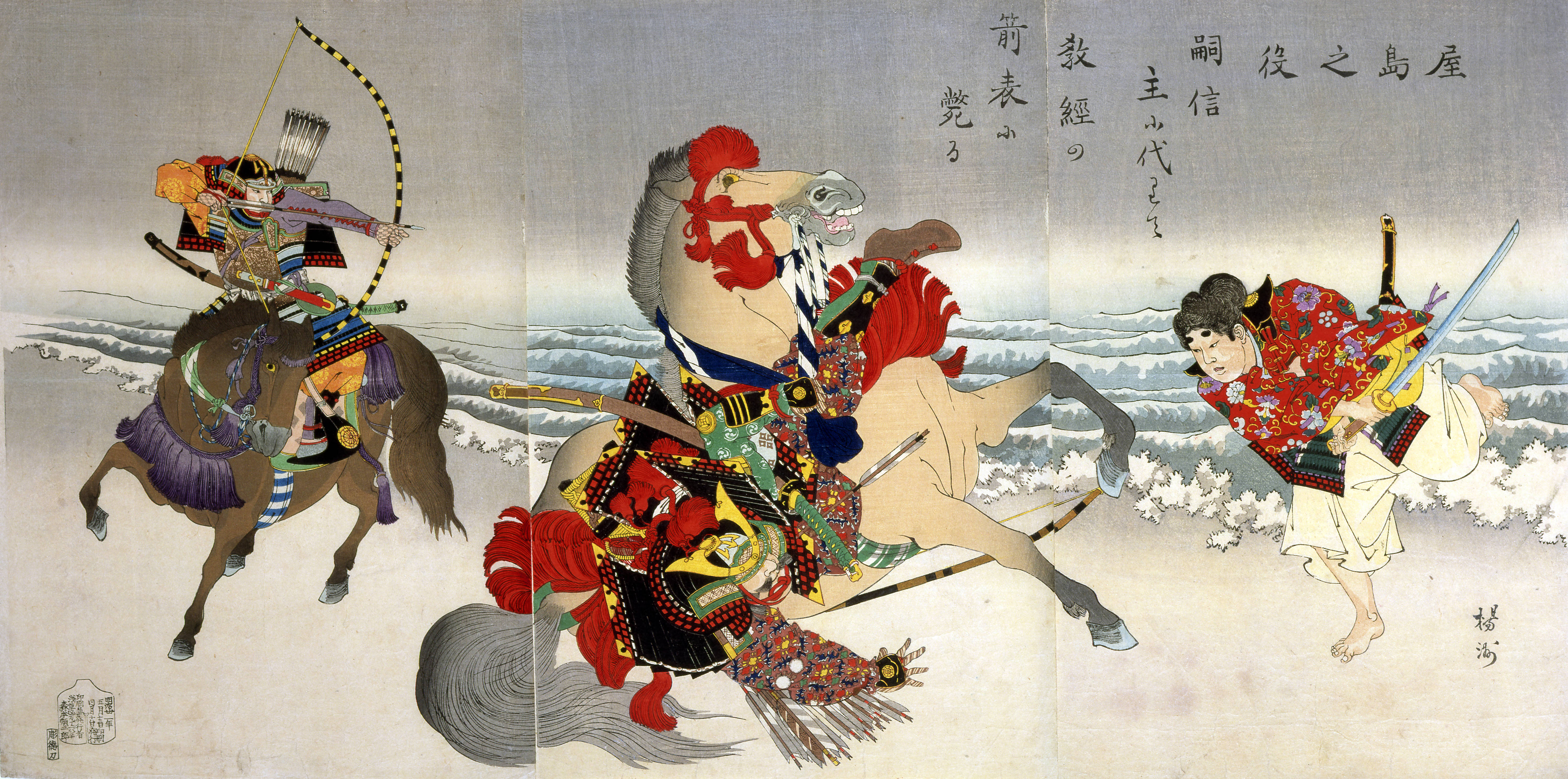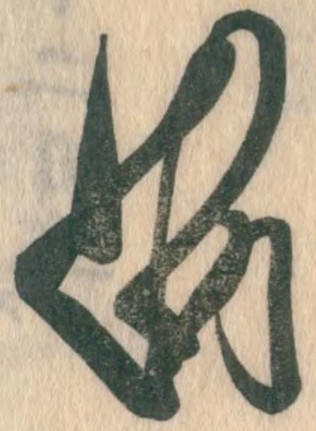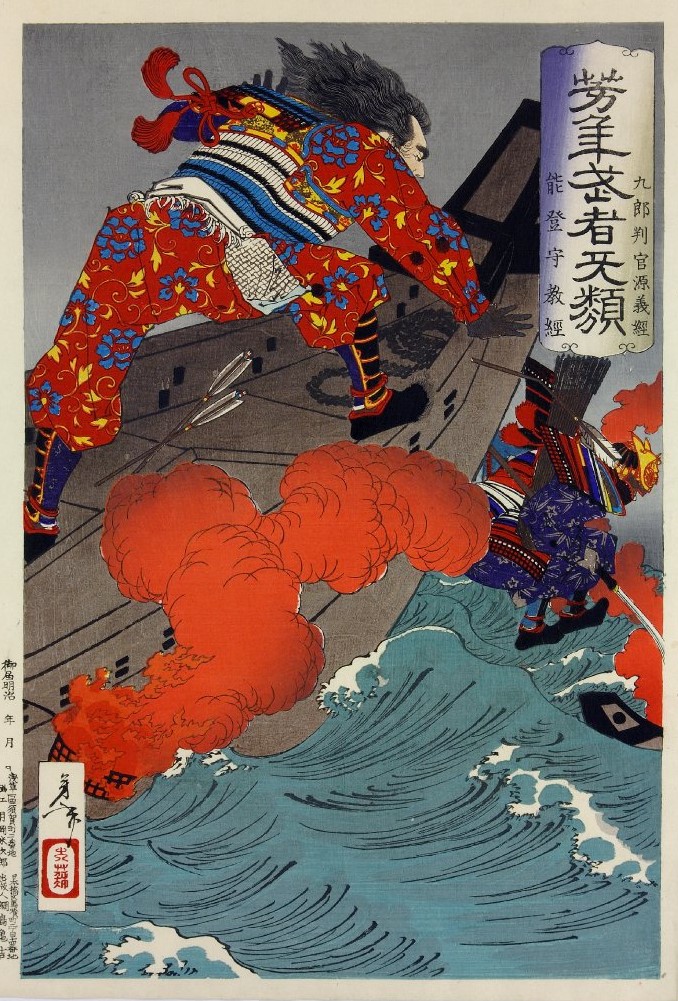|
Satō Tsugunobu
was a Japanese warrior and the brother of Satō Tadanobu. Tsugunobu died in the Battle of Yashima, while protecting Minamoto Yoshitsune from an arrow shot of Taira no Noritsune by riding between Yoshitsune and Noritsune. Tsugunobu was buried in Mure, Kagawa, by Taira no Noritsune. Tsugunobu and his brother Tadanobu "were 'given' to Yoshitsune by Fujiwara no Hidehira when Yoshitsune left Oshu to join Yoritomo". Tsugunobu is mentioned in ''Hagakure ''Hagakure'' (Kyūjitai: ; Shinjitai: ; meaning ''Hidden by the Leaves'' or ''Hidden Leaves''), or , is a practical and spiritual guide for a warrior, drawn from a collection of commentaries by the clerk Yamamoto Tsunetomo, former retainer to Nab ...'' in the passage about martial valor. References {{DEFAULTSORT:Sato, Tsugunobu People of Heian-period Japan Japanese military personnel killed in action 1158 births 1185 deaths ... [...More Info...] [...Related Items...] OR: [Wikipedia] [Google] [Baidu] |
Yōshū Chikanobu-Protecting His Master Tsugunobu
was a province of Japan, located in Kinai. It overlaps the southern part of modern Kyoto Prefecture on Honshū. Aliases include , the rare , and . It is classified as an upper province in the ''Engishiki''. Yamashiro Province included Kyoto itself, as in 794 AD Yamashiro became the seat of the imperial court, and, during the Muromachi period, was the seat of the Ashikaga shogunate as well. The capital remained in Yamashiro until its de facto move to Tokyo in the 1870s. History "Yamashiro" was formerly written with the characters meaning "mountain" () and "era" (); in the 7th century, there were things built listing the name of the province with the characters for "mountain" and "ridge"/"back" (). On 4 December 794 (8 Shimotsuki, 13th year of Enryaku), at the time of the establishment of Heian-kyō, because Emperor Kanmu made his new capital utilize the surroundings as natural fortification, the character for ''shiro'' was finally changed to "Japanese castle, castle" (). Later ' ... [...More Info...] [...Related Items...] OR: [Wikipedia] [Google] [Baidu] |
Satō Tadanobu
was a Japanese samurai of the late-Heian period. He was a follower of Minamoto no Yoshitsune. According to the ''Genpei Jōsuiki'', he was one of the , along with Kamata Morimasa, Kamata Mitsumasa, and Satō Tsugunobu. He was the younger brother of Tsugunobu, and their father was the Ōshū Fujiwara retainer Satō Motoharu. Tsugunobu and his brother Tadanobu "were 'given' to Yoshitsune by Fujiwara no Hidehira when Yoshitsune left Oshu to join Yoritomo." Yoshitsune's retreat Satō is most well known for saving his master Yoshitsune's life at Yoshino, a story recorded in the ''Gikeiki''. The story has become somewhat legendary over the years. Whilst travelling to Kyushu to escape from the troops of his brother Yoritomo, Yoshitsune and his forces were beset by the monks of Zo-o-no, and were facing defeat. Satō volunteered to fight a rearguard action to allow Yoshitsune time to reach safety, and asked for the loan of his master's armour in order to convince the pursuing troop ... [...More Info...] [...Related Items...] OR: [Wikipedia] [Google] [Baidu] |
Battle Of Yashima
Battle of Yashima (屋島の戦い) was one of the battles of the Genpei War on March 22, 1185 in the Heian period. It occurred in Sanuki Province (Shikoku) which is now Takamatsu, Kagawa. Background Following a long string of defeats, the Taira clan retreated to Yashima, today's Takamatsu, just off the coast of Shikoku. Here they had a fortress, and an improvised palace for Emperor Antoku and the imperial regalia, which they had taken earlier in the war. Battle On the 18th, a Minamoto force tried to cross the sea but many of the boats were damaged in a storm. Kajiwara Kagetoki then suggested adding "reverse oars" to the boats, which prompted an argument from Minamoto no Yoshitsune. Finally after the boats were repaired and despite the high winds, Yoshitsune departed with only five of the 200 boats carrying about 150 of his men. After arriving in Tsubaki Bay, in Awa Province. Yoshitsune then advanced into Sanuki Province through the night reaching the bay with the Imperi ... [...More Info...] [...Related Items...] OR: [Wikipedia] [Google] [Baidu] |
Minamoto Yoshitsune
was a military commander of the Minamoto clan of Japan in the late Heian and early Kamakura periods. During the Genpei War, he led a series of battles which toppled the Ise-Heishi branch of the Taira clan, helping his half-brother Yoritomo consolidate power. He is considered one of the greatest and the most popular warriors of his era, and one of the most famous samurai in the history of Japan. Yoshitsune perished after being betrayed by the son of a trusted ally. Early life Yoshitsune was the ninth son of Minamoto no Yoshitomo, and the third and final son and child that Yoshitomo would father with Tokiwa Gozen. Yoshitsune's older half-brother Minamoto no Yoritomo (the third son of Yoshitomo) would go on to establish the Kamakura shogunate. Yoshitsune's name in childhood was Ushiwakamaru or ''young bull'' (). He was born just before the Heiji Rebellion in 1160 in which his father and two oldest brothers were killed. He survived this incident by fleeing the capital with ... [...More Info...] [...Related Items...] OR: [Wikipedia] [Google] [Baidu] |
Taira No Noritsune
(1160 – 1185) was a military leader of the late Heian period of Japan. He was the son of Taira no Norimori. He fought in the Genpei War against the Minamoto clan. Genpei War Noritsune was a commander during the Genpei War. He fought in many battles including the battles of Battle of Mizushima, Mizushima and Battle of Dan-no-ura, Dan-no-ura. He also fought in the Battle of Ichi-no-Tani, and killed Satō Tsugunobu in the Battle of Yashima. Death He committed suicide in the Battle of Dan-no-ura, while holding a Minamoto warrior under each arm plunging into the sea. His father also committed suicide at the same battle. In the play, he is disguised as the priest 'Yokawa no Kakuhan', until he is forced to confess his true identity by Benkei. See also *''The Tale of Heike'' References {{DEFAULTSORT:Taira no, Noritsune 1160 births 1185 deaths Taira clan Suicides by drowning in Japan Kabuki characters ... [...More Info...] [...Related Items...] OR: [Wikipedia] [Google] [Baidu] |
Mure, Kagawa
was a town located in Kita District, Kagawa Prefecture, Japan. The north and south of the town are hilly; the center is flat and suitable for housing development. As of 2003, the town had an estimated population of 18,108 and a density of 1,098.79 persons per km². The total area was 16.48 km². On January 10, 2006, Mure, along with the town of Aji (also from Kita District), the towns of Kagawa and Kōnan (both from Kagawa District), and the town of Kokubunji (from Ayauta District), was merged into the expanded city of Takamatsu and no longer exists as an independent municipality. The town tree was the eucalyptus, and the town flower the camellia. These symbols represent ambition, good luck, longevity and positive relationships. Mure had sister city relationships with Mure, Nagano and Elberton, Georgia Elberton is the largest city in Elbert County, Georgia, United States. The population was 4,653 at the 2010 census. The city is the county seat of Elbert County. Hist ... [...More Info...] [...Related Items...] OR: [Wikipedia] [Google] [Baidu] |
Fujiwara No Hidehira
was the third ruler of Northern Fujiwara in Mutsu Province, Japan, the grandson of Fujiwara no Kiyohira. During the Genpei War, he controlled his territory independently of the central government; however, he was the official imperial governor for Mutsu Province as of 1181. He offered shelter to the young Minamoto no Yoshitsune, who had escaped from Kyoto. For many years, Hidehira was Yoshitsune's benefactor and protector, and it was from Hidehira's territory that Yoshitsune joined his brother at the start of the Genpei War. Later, when Yoshitsune incurred his brother Minamoto no Yoritomo's wrath, he returned to Hiraizumi, and lived undisturbed for a time. Yoshitsune was still Hidehira's guest when the latter died in 1187. Hidehira had his son, Fujiwara no Yasuhira, promise to continue to shelter Yoshitune and his retainer Benkei, but Yasuhira gave in to Yoritomo and surrounded the castle with his troops, forcing Yoshitsune to commit seppuku and resulting in the famous standi ... [...More Info...] [...Related Items...] OR: [Wikipedia] [Google] [Baidu] |
Mutsu Province
was an old province of Japan in the area of Fukushima, Miyagi, Iwate and Aomori Prefectures and the municipalities of Kazuno and Kosaka in Akita Prefecture. Mutsu Province is also known as or . The term is often used to refer to the combined area of Mutsu and the neighboring province Dewa, which together make up the entire Tōhoku region. History Invasion by the Kinai government Mutsu, on northern Honshū, was one of the last provinces to be formed as land was taken from the indigenous Emishi, and became the largest as it expanded northward. The ancient regional capital of the Kinai government was Tagajō in present-day Miyagi Prefecture. * 709 ('' Wadō 2, 3rd month''), an uprising against governmental authority took place in Mutsu and in nearby Echigo Province. Troops were dispatched to subdue the revolt. * 712 (''Wadō 5''), Mutsu was separated from Dewa Province. Empress Genmei's ''Daijō-kan'' made cadastral changes in the provincial map of the Nara period ... [...More Info...] [...Related Items...] OR: [Wikipedia] [Google] [Baidu] |
Minamoto No Yoritomo
was the founder and the first shogun of the Kamakura shogunate of Japan, ruling from 1192 until 1199.Nussbaum, Louis-Frédéric. (2005). "Minamoto no Yoriie" in . He was the husband of Hōjō Masako who acted as regent (''shikken'') after his death. Yoritomo was the son of Minamoto no Yoshitomo and belonged to Seiwa Genji's prestigious Kawachi Genji family. After setting himself the rightful heir of the Minamoto clan, he led his clan against the Taira clan from his capital in Kamakura, beginning the Genpei War in 1180. After five years of war, he finally defeated the Taira clan in the Battle of Dan-no-ura in 1185. Yoritomo thus established the supremacy of the warrior samurai caste and the first shogunate (''bakufu'') at Kamakura, beginning the feudal age in Japan, which lasted until the mid-19th century. Early life Yoritomo was the third son of Minamoto no Yoshitomo, heir of the Minamoto (Seiwa Genji) clan, and his official wife, Yura-Gozen, daughter of Fujiwara no Sue ... [...More Info...] [...Related Items...] OR: [Wikipedia] [Google] [Baidu] |
Hagakure
''Hagakure'' (Kyūjitai: ; Shinjitai: ; meaning ''Hidden by the Leaves'' or ''Hidden Leaves''), or , is a practical and spiritual guide for a warrior, drawn from a collection of commentaries by the clerk Yamamoto Tsunetomo, former retainer to Nabeshima Mitsushige (July 10, 1632 – July 2, 1700), the third ruler of what is now Saga Prefecture in Japan. Tashiro Tsuramoto compiled these commentaries from his conversations with Tsunetomo from 1709 to 1716; however, it was not published until many years afterwards. Written during a time when there was no officially sanctioned samurai fighting, the book grapples with the dilemma of maintaining a warrior class in the absence of war and reflects the author's nostalgia for a world that had disappeared before he was born. ''Hagakure'' was largely forgotten for two centuries after its composition, but it came to be viewed as the definitive guide of the armed forces of the Empire of Japan during the Pacific War. ''Hagakure'' is also known as ... [...More Info...] [...Related Items...] OR: [Wikipedia] [Google] [Baidu] |
People Of Heian-period Japan
A person ( : people) is a being that has certain capacities or attributes such as reason, morality, consciousness or self-consciousness, and being a part of a culturally established form of social relations such as kinship, ownership of property, or legal responsibility. The defining features of personhood and, consequently, what makes a person count as a person, differ widely among cultures and contexts. In addition to the question of personhood, of what makes a being count as a person to begin with, there are further questions about personal identity and self: both about what makes any particular person that particular person instead of another, and about what makes a person at one time the same person as they were or will be at another time despite any intervening changes. The plural form "people" is often used to refer to an entire nation or ethnic group (as in "a people"), and this was the original meaning of the word; it subsequently acquired its use as a plural form of per ... [...More Info...] [...Related Items...] OR: [Wikipedia] [Google] [Baidu] |
Japanese Military Personnel Killed In Action
Japanese may refer to: * Something from or related to Japan, an island country in East Asia * Japanese language, spoken mainly in Japan * Japanese people, the ethnic group that identifies with Japan through ancestry or culture ** Japanese diaspora, Japanese emigrants and their descendants around the world * Japanese citizens, nationals of Japan under Japanese nationality law ** Foreign-born Japanese, naturalized citizens of Japan * Japanese writing system, consisting of kanji and kana * Japanese cuisine, the food and food culture of Japan See also * List of Japanese people * * Japonica (other) * Japonicum * Japonicus * Japanese studies Japanese studies (Japanese: ) or Japan studies (sometimes Japanology in Europe), is a sub-field of area studies or East Asian studies involved in social sciences and humanities research on Japan. It incorporates fields such as the study of Japanese ... {{disambiguation Language and nationality disambiguation pages ... [...More Info...] [...Related Items...] OR: [Wikipedia] [Google] [Baidu] |






_1938.jpg)